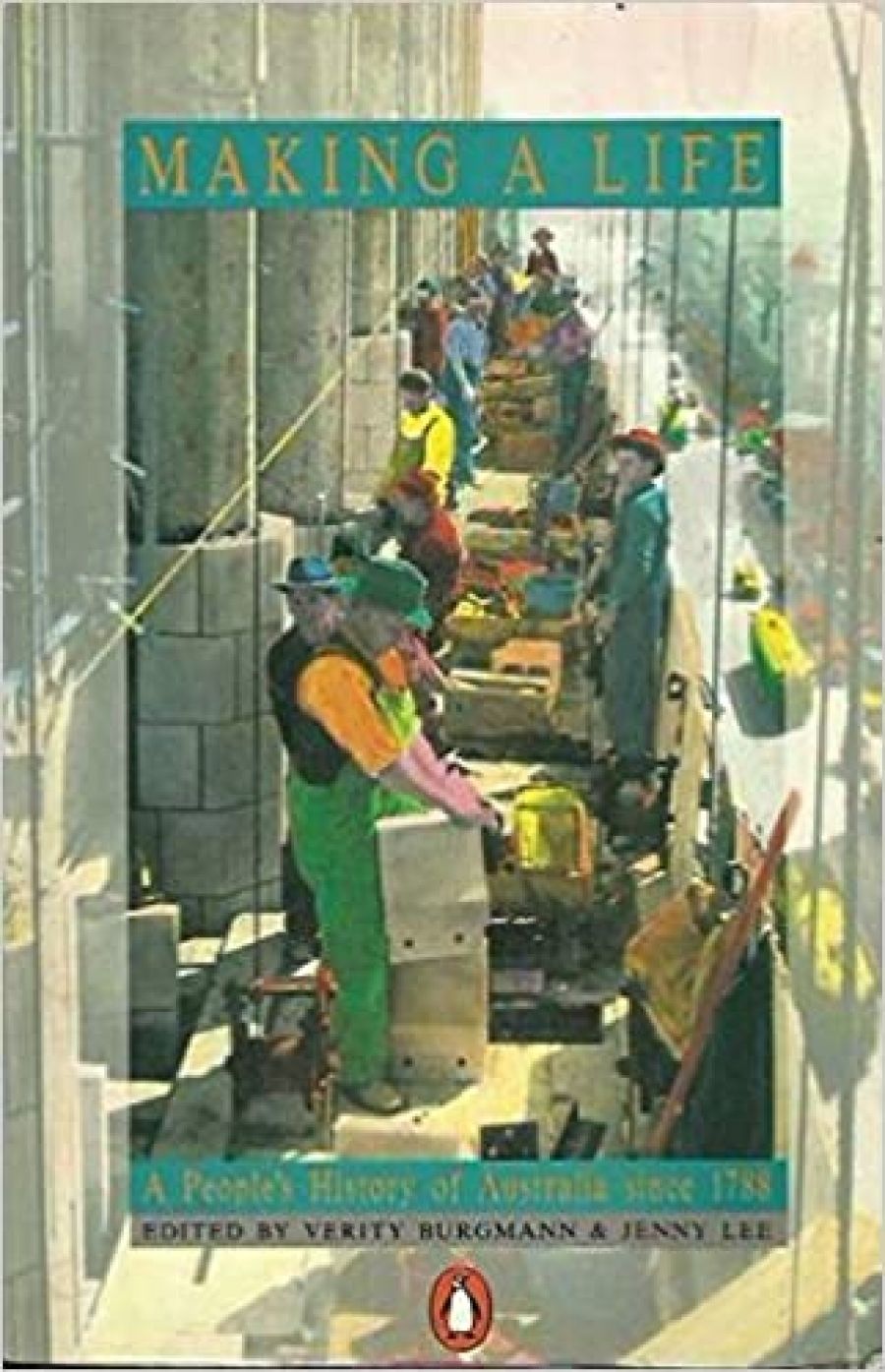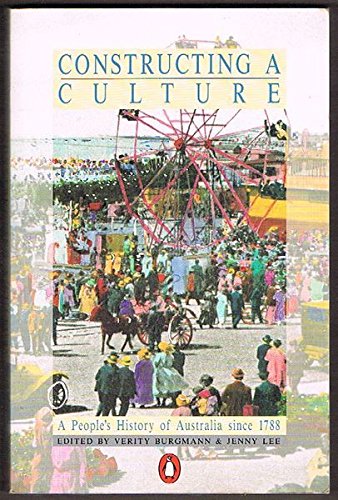
- Free Article: No
- Contents Category: Australian History
- Review Article: Yes
- Article Title: Which people is this history for?
- Online Only: No
- Custom Highlight Text:
The title A People’s History of Australia is certainly a grand one. Its multi-volume predecessors have more modest titles, such as Clark’s disarmingly simple A History of Australia or the eleven-volume Australians: a historical library. The People’s History’s aspirations go beyond content to embrace audience. This is refreshing to see as many Australian scholars still regard their colleagues as the only audience that matters. The editors say in their introduction that:
- Book 1 Title: Making a Life
- Book 1 Subtitle: A people's history of Australia
- Book 1 Biblio: McPhee Gribble, $16.95 pb, 351 pp
- Book 2 Title: Constructing a Culture
- Book 2 Subtitle: A people's history of Australia
- Book 2 Biblio: McPhee Gribble $16.95 pb, 325 pp
- Book 2 Cover Small (400 x 600):

Who are these notional people? The obvious victims in our society are well covered in Making a Life which breaks new ground with its concentration on the workplace. But I’m not sure that many PAYE taxpayers will recognise themselves in these pages. There is an account of the arbitration system, but not the taxation system, despite the fact that minimising tax has been one of the main sources of capitalist wealth in this country. There are just a few limes on the distribution of wealth even though income and life changes are among the key themes of this volume.
There is an account of nineteenth and early twentieth century landlordism but little discussion of why over two-thirds of all working-class families own or are purchasing their homes. From reading this book you could easily get the impression that high rents, the shortage of rental accommodation, and the tyranny of week-to-week leases were a thing of the past. The political dilemma, and these volumes are admirably open about their political intent, is that there is no longer ‘a great ring of landlords’, if there ever was. The ALP had to reintroduce negative gearing, not only to try and take some of the steam out of rent increases but to ensure that it didn’t alienate its property-owning constituency. The aspirations of these property holders are well understood by the current federal cabinet, many of whom, like their Liberal predecessors, own at least two properties.
Constructing a Culture is a misleading leading title for a book that includes almost no account of our material culture, even though the editors tell us in their introduction that ‘culture does not only live inside the walls of theatres, art galleries, concert halls and literary ghettos’. Have the editors and their contributors been lingering too long in such places? Most of the exciting work on the artefacts of everyday life, from the kitchen to the factory floor, is taking place night now in our museums but none of these practitioners have written for the series. More space is devoted to a telling and sometimes amusing critique of arcane academic journals than to an explication of the icons of working-class life in Australia in the 1950s and l 960s, the car (most notably symbolised by the Holden) and the refrigerator. These two products, the virtual preserve of the middle class in the interwar years, were, by the end of the 1960s, to be found in almost all working-class homes.
The failure to acknowledge the importance of material culture is glaringly apparent in the unimaginatively selected, poorly reproduced, and crudely captioned illustrations. What are we to conclude from the photograph of ‘a house in Toorak, Melbourne, built in 1904’, the jejune caption for a mansion, depicted in Bernard Smith’s chapter. I think it highly unlikely that he wrote it in what is otherwise a masterly short survey of art and architecture. ‘Ian Turner at a party in October 1973’ shows him bearded, tieless, and apparently drinking beer. This illustration is in Milner’s provocative chapter on radical intellectuals, not in Dunstan’s on boozers and wowsers. Yet one of Turner’s great contributions to Australian cultural life was to attack the wowserism so rife in Australian academia.
The prize for the best caption (most essays have at least two illustrations) has to be awarded to the transport chapter in Making a Life. ‘From horse-drawn to air borne’, which shows a sulky in front of an aeroplane, would be funny if it was a comment on crude notions of technological progress, but there is no hint of this in the chapter. Indeed the author, Wotherspoon, who is sound on urban public transport, misleadingly suggests that our airlines now cater to a ‘mass market’. In fact over half of all domestic trips are made by people whose fares are paid for them or who can tax deduct their fares. Businessmen and senior public servants fly often, the working class rarely fly.
The failure to integrate illustrations with text is part of a wider lack of thematic integration in the volumes. They are made up of a series of short, discrete essays, of 5000 to 7000 words, with little relation between each essay save for the occasional cross reference. These volumes would be better and more usable books if the existing chapters had been grouped under overall themes, with the 200-year survey chapters as openers, followed by the case study chapters. In Making a Life the chapters on childhood, marriage, family life, and the sexual division of labour in the home could be drawn together by a simple introduction on the Australian household. The chapter on fashion would be much better placed with John Docker’s lively piece on ‘Popular Culture and Bourgeois Values’ in the Culture volume.
In his review of the first volume in this series ‘A Most Valuable Acquisition’ (ABR March) Manning Clark wrote of the chapters ‘They are all very, very worthy. The difficulty for a writer in such a vein is how to be worthy without being dull’. Most of the chapters in Making a Life, if not dull, are certainly pessimistic. This is for the simple reason that for most of the people that the authors focus on, living wasn’t always much fun. The tone of the book is well summed-up in the conclusion to the chapter by Jan Kociumbas on childhood. She writes:
It is the experience of the Aboriginal child that best illustrates the continuing gap between rich and poor, the way in which in Australian society, one’s place has always been learned when young.
Callous readers desperate for light relief should turn immediately to the late Keith Willey’s witty essay on Australian humour in the Culture volume, witty even though it acknowledges the racism and sexism inherent in much of our humour. Marilyn Lake’s thoughtful piece ‘Intimate Strangers’, about the way in which women have made their way in a patriarchal society, would have been livelier had she swiped (from John Docker’s chapter) the marvellous sketch by Mo of a lecherous judge trying the case of a man accused of robbing an attractive young woman. It can be a very fine line between sex as fun and sex as abuse. It is not fashionable for feminists to comment on that line but it could have been done in these volumes.
A People’s History has been a brave undertaking. The editors have co-ordinated the work of over seventy authors, including a high proportion of younger scholars with limited experience in writing for the mass market. Most of the chapters read well and that is undoubtedly a tribute to the editors as well as the authors. Put together on a ludicrously small budget, is it yet another indication that universities are loath to support other than the endeavours of the senior staff who control the purse strings. It is also further evidence that Australian publishers are reticent about putting money into book production. The series would be better off without its woefully reproduced illustrations, especially as they are of largely decorative intent.
This series was in part conceived, as its editors explain, as a reaction to Australians: a historical library, produced in expensive full colour by Fairfax, Syme, and Weldon. The People’s editors erroneously describe this set as ‘the official bicentennial history’ an ironic slip since Penguin, publishers to the People, are the real purveyors of that imprimatur, having produced John Molony’s ABA sponsored history of Australia, replete with logo. The People’s History and the Historical Library have a lot in common. They are multi-author works, sharing between them over a dozen authors, their authors cover a broad political spectrum (although more of the People are left of centre) and both series were typeset and printed in Australia.
The People has been published at a modest price, around $70 for the paperback set of four. Most students will be able to purchase at least one volume and that is a good thing. The 12,000 people who have so far purchased the Historical Library have been prepared to pay ten times that amount. The People also deserves a wide readership, but in the age of marketeers, where appearance and PR can be almost as important as content, the People would sell more if the volumes were better printed and more sturdily bound. Most readers would be prepared to pay a few more dollars for a better-quality production. A People’s History, with a little reorganisation, deserves a longer life than its publishers envisage.


Comments powered by CComment